Raigad is one of the best places in the history of the Hindu Swarajya, 2 km north of Mahad. The fort is 5 feet high above the sea level.
HISTORY OF RAIGAD:
Raigad is surrounded by mountains. To the north and east, the river basins are
spread. The Gandhari river flows to the west. To the east, Lingana, Agnea, the
sky is clear, while Rajgad, Torana is to the south. Mumbai, Pune and Satara are
the same distance from Raigad. This is a link between the rows of Sahyadri
forts. Since Raigad is surrounded by mountains by nature (as well), Maharaj
chose Raigad, the capital of the western mountains, to leave Pune to escape the
enemy attack.
History: The ancient name of Raigada was 'Riri'. Europeans
used to call it 'Gibraltar in the East'. Gibraltar's Thane is as invincible as
Raigad Ajinkya, inaccessible. Five hundred years ago, when it had no form of
fortress and was merely a hill, it had two names Rasivata 'and' Tans'. Due to
its height and height, it was also known as 'Nandadip'. In the Nizamism, Raigad
was used to keep prisoners. Moray's chief Yashwantrao Moray fled Jawali and
stayed on Raigad while Prataprao Moray fled to Vijapura. Maharaj laid siege to
Rairais, ie, Raigadas on April 8, and in the month of May, Rairai took over.
Mullah Ahmed, the well-wisher of Kalyan, came to Bijapur with the treasure and
learned that the Maharaja was on his way. They looted the treasure and brought
it to Raigad and used that treasure for the construction of the fort.
The head of Raigada is convenient and sufficient to make the
capital. It is the most difficult place in the region where the enemy finds it
difficult. This place is also close to sea transportation. So the Maharaja
chose this fort for the capital. Member Bakhar says, “The king is very dark and
very dark. One and a half villages high, as per the four-sided fort. The grass
does not grow on the rainy season and the stone tassive is the only one.
Daulatabad is a solid stronghold on earth, but it is a little high. Dishon was
very satisfied and spoke as he was twice taller than Daulatabad. This is where
the table should be built. ' This Durgadurgeshwara is referred to by 3
different names. Raigad, Ryari, Islamgarh, Nandadeep,
Jambudwip, Weed, Zodiac, Badenur,
Raigiri, Bhiwagad, Reddy,
Shivanka, Rahir, The anointing of the Shivajiya of Gibraltar in
the East Shivarajibhishek The best occasion experienced by Raigad is the
coronation of the Maharaja, a significant event in the history of not only
Maharashtra but in India. Prior to the coronation rites on May 29, Maharaj saw
the Bhavani at Pratapgad. Three gems were offered to the goddess Chhatra, which
is worth Rs 5,000. Talks in the Rajya Sabha on the fort. The coronation was concluded
on Saturday, June 7, the first day of the purification of the 1st Shaku. September 7, Lalitha Panchami Ashwin S. Anand Samvatkar may have arrived on
this day in 1919. The real purpose behind this was to please as many people as
possible.
This coronation was accomplished at the hands of Nishalpuri
Gosavi. Poet Bhushan describes Raigad, 'Shivaji made it his home if Raigad fort
was the basis and luxury of all the forts. The fort is so huge and vast that it
has the glory of all three people. There are wells, lakes, wells on the fort.
After winning all the yavas, King Shivaji made capital on Raigad and achieved
the greatest success in the world by providing the people with his wishes. On
February 2, 1939, Anand Sawtsar Marg and Sambhaji Raj's Munj took place at
Raigad on Thursday. The suspect, Siddhartha Samvatasar Falgun, and Rajaram
Maharaj's Munj took place on Raigad on 7th March. Eight days later, Rajaram
Maharaj was married to Prataprao Gujar's daughter. The most tragic event
experienced by Raigad is that the Maharaja may die. Maharaj passed away on
April 7. Member Bakhar says, 'The earthquake happened that day. The eighth
direction is gone. The blood of Srisambhumahadevi lake is gone. ' 3 BC On
February 29, Sambhaji Maharaj's legislative throne took place at Raigada.
Places to see on the fort:
1. The Jijabai
Castle of Pachad: In the course of landing, the Jizabai's cold air on the fort,
the wind is not human, so Maharaj built a palace near them. That's where the
masters lived. The Maharaja had also arranged for some officers and soldiers to
keep the palace in order. A great well for stairs, as well as a stone seat made
for jijabai to see. Also known as a 'water well'.
2. Big Tower: The
tower began to appear as a tower, it was a well-known tower, a door beside the
tower, called the 'Cheet Darwah', but this gate has now been completely
demolished.
3. Nana Door:
These doors are also called 'coin door'. The fact that this door is associated
with Nana Fadnasis is completely absurd. Nana door means small door. C. On the
occasion of the coronation of May 8, the British lawyer Henry Oxendon came to
the door. This door has two arches. Inside the door there are two small rooms
for the guard. They are called 'gods'. The knobs appear to block the door.
4. Madarmorcha or
Masidarmorcha: When the Chitta door enters, a flat path is taken as you go
along the road leading to the Nagmodhi turn. In this open space there are two
paved buildings. One of them is a watchman's place, and the other is a
storeroom. Here is the tomb of a monk named Madanshah. A huge cannon appears
here as well. Going from here you can see three caves excavated in the rock.
5. Mahadarwaja: On
the outside of the palace there are two beautiful lotus carvings engraved on
both sides. These two lotuses at the door mean 'Shri and Saraswati' inside the
fort. Shri and Saraswati means Vidya and Lakshmi. The palace has two
magnificent towers, one being 3 feet high and the other 3 feet high. The
downpours that are located in the embankment are called 'corrosion'. They are
hungry to attack the enemy. The door between the towers is facing northwest.
Upon entering the courtyard, the guards of the guard appear, as well as the
living room for the guard. The embankment is bounded from the main courtyard to
the right end and the right side to the left.
6. Chorindi: If
you walk through the embankment that goes from the palace to the right, to the
periphery of the tower, where the embankment ends, this little tower has
recently been built. There are steps to the tower from the inside to the door.
7. Elephant Pond:
The elephant pond which is visible a little further from the courtyard. The
pond was used for bathing and drinking elephants coming from the yard.
8. Gangasagar
Lake: From Hattilavwa, the Dharamshala buildings of Raigad Zilla Parishad are
visible. Gangsagar Lake, which is about 3-5 steps from Dharamshala to South.
After the coronation of the Maharajas, the pilgrims brought by the Satpasagar
and Mahanadas were thrown into this lake. Hence it was called Gangasagar. Its
water was used for sewage during Shivakad.
9. Pillar: Two tall monasteries are seen to the south of the
Ganges. That is what is called a column. The pillar mentioned in the
inscription of Jagadishwara. That's what they should be. They were previously
said to be five floors. It is a two-cornered corner and carved in the
construction.
10. Scaffolding
door: From the wall to the west of the pillars, there are 3 steps constructed.
Climb the door that leads to the door. From this door you can access your balcony.
11. Wax door: Once
the palanquin door enters, a straight path leads up to the wax door. The seven
relics on the right hand side are the palace of the queens. The wax can be
accessed from the door at the bottom.
12. Raj Bhavan: In front of the queen, left hand side of the
queen's house is seen. Behind these relics, there is another parallel wall,
which is in the middle of the wall. The fourth floor of the palace is 5 feet
long by 3 feet wide.
13. Rattanshala:
This is the basement of a cellar in the open space on the east side of the
columns near the palace. It is also said to be a private room.
14. Rajya Sabha:
This is where the Maharaja's coronation took place. The Rajya Sabha is 5 feet
long and 3 feet wide. This is where the throne facing east lies. There was a
gold throne of thirty-two gems. Member Bakhar says, 'Takht has proved
thirty-two gems of gold. Navaratne was in the same cell as Amolik. Finding it
and adding large gems to it '.
15. Nagarkhana: The
hall which looks like a grand entrance in front of the throne. This is the main
gateway to Balekil.
16. Bajarpeth: As
we come to the left from the nursery, the 'Holi mall' which appears in front of
us is empty. There is now a huge statue of Shiv Chhatrapati sitting. The
magnificent relics that appear in the two rows in front of the statue are the
only ones in the market. There are 2 shops in each of the two paths of Peth.
About forty feet wide is the road.
17. Shirkai Temple:
Shirkai Temple is the small shrine that appears on the left side of the
Maharaja's statue. Shirkai is the main deity on the fort.
18. Jagadishwara
Temple: On the lower slope of the market, the ruins of Brahmanaswati,
Brahmanatals etc. are visible on the eastern slope. From there, the magnificent
temple which appears in front of it is the temple of Mahadeva, the temple of
Jagadishwara. In front of the temple is a magnificent and beautiful statue of
Nandi. But now the idol is in ruins. When you enter the temple, a large
gathering takes place. In the center of the tent is a massive tortoise. A
magnificent statue of Hanumanta is seen on the wall of the cave. A small
inscription appears below the stairs at the entrance to the temple. It looks
like a beautiful inscription on the wall to the right of the door: 'Shri
Ganpataye Namaskar': Prasado Jagadishvariya Jagatam Dadaunyugya Shrimachtrapte:
Shivasanaparte: The throne. Shake ShabanavabhanabhumiDanganDanasSatara
JyothirajMuhurt Kartaamithe ShukleshSapiThathau 29 VapiKupadagarajirachuram
Rumiyaan forest wittiku stabha: Aquarius narendrasadanarebharanheli mehite. .
Srimadraigirou village matters diamond diamonds or yachchandradiwakarou
willsastavatsamjambrambte 29 The brief meaning of this is as follows: - 'This
world is pleasing to all the world, by the order of Shrimad Chhatrapati Shivaji
Raja, the Prasad of Jagadishvara, built on the Sumahuurta in the year 1929,
when the Anandanam Samvatas were in progress. On this Raigada, a sculptor named
Hiroji has raised hopes for wells, ponds, gardens, roads, pillars, gajashalas
and palaces. Don't be so happy as it is the moon.'
19. Maharaja's
Tomb: The octagonal square that appears a short distance from the east gate of
the temple is the Maharaja's tomb. Member Bakhar says,
"Kshatriyakulavatans Shri. They are built up of a meaningful body and the
cavity is below the pavement above. There is a remnant of Maharaja's remnant.
”Beyond the cemetery there is a row of ruins of broken buildings. It should be
an encampment. Beyond this there appears a fourth of a house separated from the
town. This house In 1674, was given to an English lawyer, Henry Oxendon, to
stay. On the east side of the mausoleum of the Maharaja is Bhavani Tok, while
on the right there are barns of wine, twelve tanks.
20. Kushavart Lake:
Holi Mal leaves the left hand side and goes to Kushvart Lake on the right. A
small shrine of Mahadev appears near the lake. Nandi is seen in front of the
temple.
21. Tiger Door: A
tiger can come to the door by a clockwise landing near Kushwar Lake. The
scripture says, 'For a fortress to the fort is a great ibid; In this case, the
Maharaja built the door without the Mahadarwaja, keeping this visionary policy
in mind. Although it is almost impossible to get up through this door, one can
go down the drain. Later, Rajaram Maharaj and his congregation broke the siege
of Zulfiqar Khan and escaped through this door.
22. Tommile Point: The market can come down to the front end
by descending from the front of the pit. There remains the remains of a wine
closet. As we approach the end, the road becomes steep. The right hand has a
straight broken 3 foot deep edge. Be careful not to mess with the wind as the
wind is heavy and low in space.
23. Hirakani Tip:
The hilly tract that runs west to the right of the Ganges Sea leads to the
Hirakani Point. A story about the Hirakani gawalani is told in connection with
the Hirakani tip. There are also some guns placed on this tower. Standing on
the tower, the Gandhari basin on the left hand side and the valley of the Kala
river on the right. Also from this place are the Pachachad Bulbudas, the Masjid
Morchas. Therefore, it is a very important and important place in the field of
war as well as in combat.
HOW TO REACH THE FORT:
1. From Mahad bus station on Mumbai-Goa route: Buses for
Raigad depart from Mahad bus station on Mumbai-Goa route. There are also jeeps
from outside the bus station. When the bus arrives, Chitta goes down the stairs
to the gate, which no longer exists. After climbing about 5 steps, we enter the
fort through the palace.
2. Even from Nana Darwaza: We can also climb from Nana door.
The steep road that leads up the stairs leads a little further to the right and
goes one foot to the right. If we go down that path, we can climb up the slope.
3. Rope-Way: Now we can reach the fort within 10-15 minutes
from the footpath as the ropeway is arranged to reach the fort.
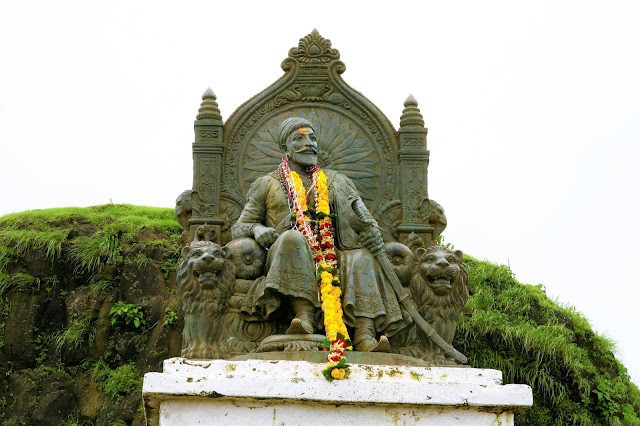

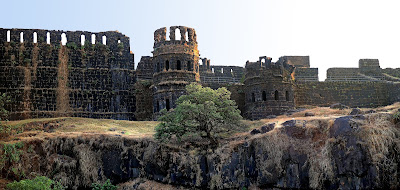
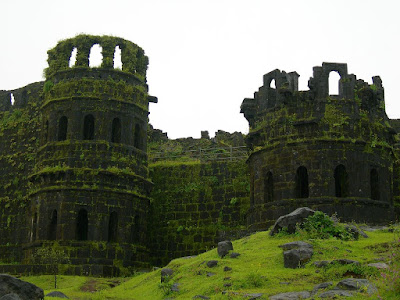

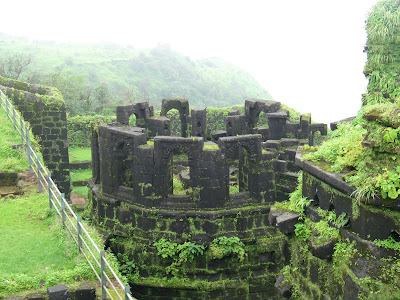

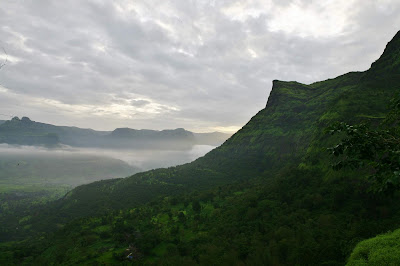
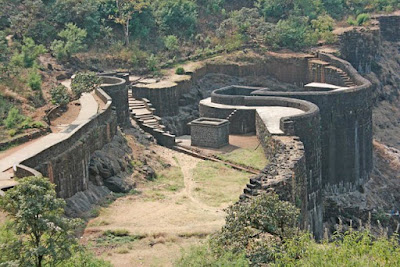






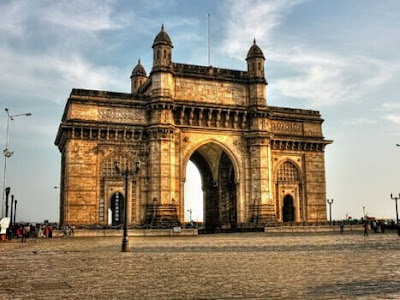








No comments:
Post a Comment